5 Best Practices for Social Media Community Management
Did you know that 40% of consumers expect brands to respond to their social media messages within an hour? In today’s hyper-connected world, social media community management isn’t just about posting updates, it’s about developing meaningful connections. It’s the art of listening, engaging, and nurturing relationships with your audience, turning followers into loyal advocates.
Effective community management goes beyond likes and shares. It’s about creating a space where conversations succeed, feedback is valued, and problems are solved before they escalate.
When done right, it boosts engagement, builds trust, and even transforms customers into brand ambassadors—ignoring it? That’s like leaving money on the table or risking your reputation.
So, how do you master this important skill? In this blog, we’ll break down the social media community management best practices for you, from crafting authentic responses to leveraging data-driven insights.
Whether you’re a startup or a global brand, these strategies will help you turn your social channels into thriving communities, one meaningful interaction at a time.
What is Social Media Community Management?
Social media community management is all about people, not posts. It’s the ongoing process of engaging with your audience across platforms like Instagram, X (formerly Twitter), LinkedIn, Reddit, and Quora to build meaningful relationships.
Unlike social media marketing, which focuses on publishing content to a wider audience, community management is about the one-on-one and one-to-few interactions that drive organic social media growth.
Think of it as hosting a dinner party rather than putting up a billboard—you’re present, responsive, and making guests feel heard and welcome. This human touch turns casual followers into loyal fans.
Here’s what community management on social media looks like:
- Responding timely and authentically to comments and DMs.
- Encouraging user-generated content and highlighting your community.
- Engaging in relevant discussions on niche forums or industry threads.
Brands like Glossier excel at this. They reply with personality, listen to feedback, and treat their community like collaborators, not just customers. That’s where real loyalty is born.
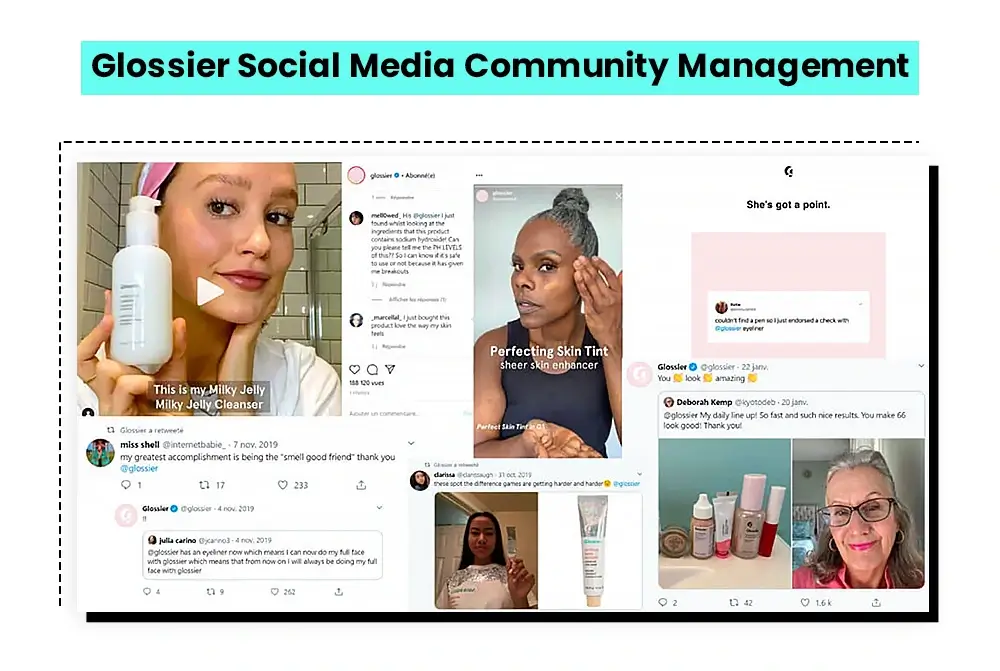
What are Common Use Cases for Social Media Community Management?
Successful social media and community management go far beyond just posting; it’s about being present, responsive, and intentional. While every brand’s strategy may differ, certain core responsibilities remain consistent:
- Customer Support: Quickly responding to questions or concerns helps build trust.
- Audience Engagement: Sparking conversations and encouraging interaction keeps your community vibrant.
- Feedback Aggregation: Listening to your audience offers insights to guide product and service improvements.
- Lead Generation: Engaging content can attract and nurture potential customers.
- Crisis Management: A calm, timely response can turn a negative into an opportunity.
These use cases are essential for running a successful social media presence.
Why is Social Media Community Management So Important?
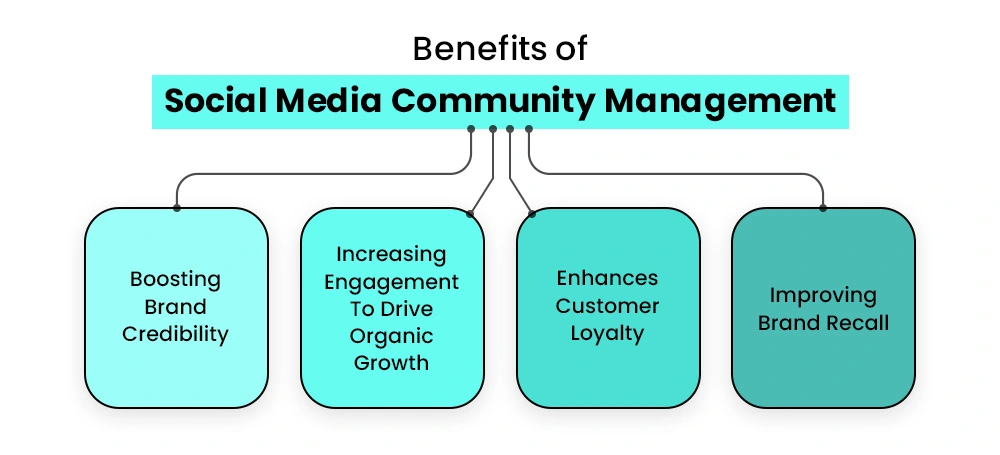
There are several benefits of effective social media community management. By creating meaningful relationships and encouraging active participation, brands can unlock various advantages. Let’s take a look at some of them:
1. Boosting Brand Credibility
Effective community management on social media builds authentic connections that lead to lasting brand loyalty. When people feel heard and valued, they’re more likely to stick around and advocate for your brand.
Around 70% of consumers feel more connected to brands whose leaders are active online, showing that strong communities directly boost credibility and trust.
2. Increasing Engagement To Drive Organic Growth
Great community management fuels content that resonates, and that’s what sparks real engagement. When your audience feels connected, they naturally like, comment, and share, leading to powerful word-of-mouth and organic growth.
Around 86% of customers are willing to pay more for a better experience, proving that strong community management delivers both value and ROI.
3. Enhances Customer Loyalty
An engaged online community doesn’t just follow your brand, they support it. Nearly 80% of customers say their experience with a company is just as important as the product itself.
When you consistently show up and connect with your audience, you create positive experiences that turn happy customers into brand advocates. And loyal customers? They spend 67% more than new ones, proof that the community truly drives long-term value.
4. Improving Brand Recall
A strong social community helps your brand stay at the top of your mind, and that’s huge. Around 39% of brand perception is shaped by brand recall.
When you actively engage and show up with a consistent brand voice, people remember you. This not only protects your reputation but also fuels word-of-mouth marketing, attracting new customers and driving growth simply by being present in the right conversations.
– Also Read- How to Boost Organic Social Media Growth for Ecommerce Business?
How To Create A Social Media Community Management Strategy?
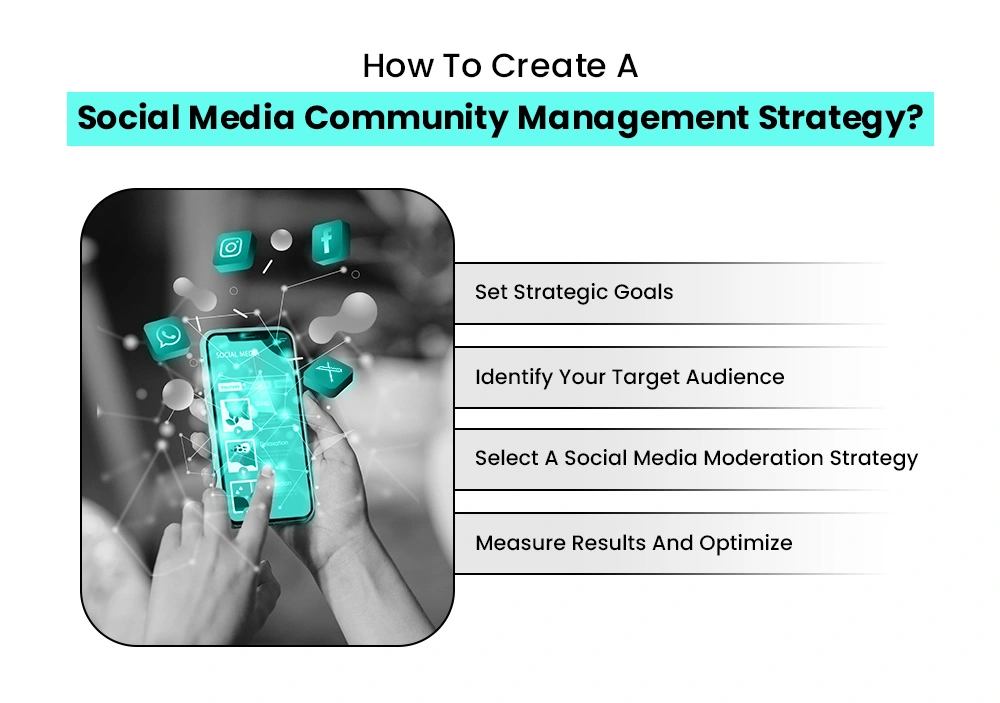
Successful social media community management might look easy, but it’s a skill built on strategy and intention. Every thoughtful reply supports stronger relationships and real results.
Ready to level up your approach? Here are some actionable tips to help you manage your community more effectively.
1. Set Strategic Goals
The first step in building an effective social media community management strategy is setting clear, realistic goals. Start by aligning with your broader business objectives, whether that’s growing brand awareness, increasing conversions, or boosting customer loyalty.
Then, translate those goals into measurable KPIs that guide your daily actions. For example:
- Want to build loyalty? Track positive sentiment and repeat engagement.
- Focused on conversions? Increase proactive engagement on product-related content creation.
The key is to make your goals actionable and tied directly to outcomes that matter to your brand. That way, every interaction supports a larger purpose.
2. Identify Your Target Audience
A strong community management strategy starts with knowing where your audience spends their time. While owned communities are valuable, real impact comes from being active on the social media platforms your audience uses most.
To get started:
- Identify where your followers are most engaged—Instagram? LinkedIn? Reddit?
- Tailor your content and brand voice to fit that platform’s culture.
- Avoid spreading yourself too thin. Focus on quality over quantity.
Using a social media management tool can help you track engagement and prioritize platforms that drive results. This ensures you’re building genuine connections where they count most and not wasting energy where your audience isn’t listening.
3. Select A Social Media Moderation Strategy
Creating a strong moderation strategy is a key part of any successful social media community management plan. Think of it like setting ground rules for a lively gathering when everyone knows what’s expected, your community members feel safe, respected, and encouraged to engage.
Moderation isn’t about control, it’s about creating space for authentic, positive connections. Without clear guidelines, brands often fall into common social media marketing mistakes like inconsistent messaging or poor handling of negative feedback. Here’s how to avoid that:
- Define your brand voice and community culture: Decide whether your tone is professional, playful, or somewhere in between. This shapes the environment you want to foster.
- Set response protocols: Plan how to address complaints, questions, and negative comments. Make sure your team is trained to respond quickly and with empathy.
- Prepare for concerns: Have a clear escalation path for handling trolls, inflammatory comments, or potential PR issues. Empower your team to act decisively when needed.
A well-moderated space invites discussion, protects your brand’s reputation, and encourages community members to connect more deeply with your brand; something no bot or auto-responder can replace.
4. Measure Results And Optimize
Tracking results is a crucial step in your social media community management strategy—not just for reporting, but for real growth. It helps you prove the value of your efforts and refine what’s working. Focus on metrics like:
- Engagement rate: Are your followers actively participating?
- Sentiment analysis: Is your brand being talked about positively?
- Conversions: Are your interactions leading to action?
Use this data to understand audience preferences and fine-tune your strategy. The best community management isn’t static; it evolves with your audience and aligns with your brand’s larger goals. Think of it as a feedback loop that keeps you improving.
5 Social Media Community Management Tips
Prioritizing community management in social media can unlock lasting brand loyalty, but only with consistency. It’s more than likes and replies; it’s about building real relationships.
Use these five proven tactics to strengthen your strategy and turn everyday followers into lifelong fans. Let’s dive into the best practices.
1. Build A Strong Foundation
Before diving into community conversations, it’s important to set a clear direction for your social media community management efforts. Start by defining what success looks like for your brand.
Are you aiming for brand awareness, stronger customer support, or building brand advocates? Align these goals with your immense social media marketing strategy to ensure every interaction supports your brand’s growth.
Next, take the time to deeply understand your audience. Research which social media platforms they’re most active on and create audience personas that reflect their interests, pain points, and online behavior. This will help you craft content and responses that feel genuinely engaging.
Equally important are your social media community management guidelines. Set clear rules for how people should interact within your community—what’s welcome, what’s not, and how moderation will be handled. This creates a safe, inclusive space where people feel comfortable participating.
Pro Tip: Nike does this brilliantly. Their @NikeRunning community isn’t just about shoes—it’s about connection. From community challenges to celebrating personal records, Nike knows how to celebrate milestones and keep fans motivated and engaged.
Lay this foundation, and your community will have everything it needs to thrive.
2. Prioritize Proactive Engagement
A winning social media community management strategy balances both reactive and proactive tactics. While responding to comments and DMs boosts loyalty, proactive engagement helps grow your reach and influence.
Think about the comment section of a viral TikTok—you’ll often see brands like McDonald’s or Ryanair cleverly joining conversations, even when the content doesn’t mention them. These social media community management examples showcase how brands can boost visibility by being timely, relevant, and entertaining.
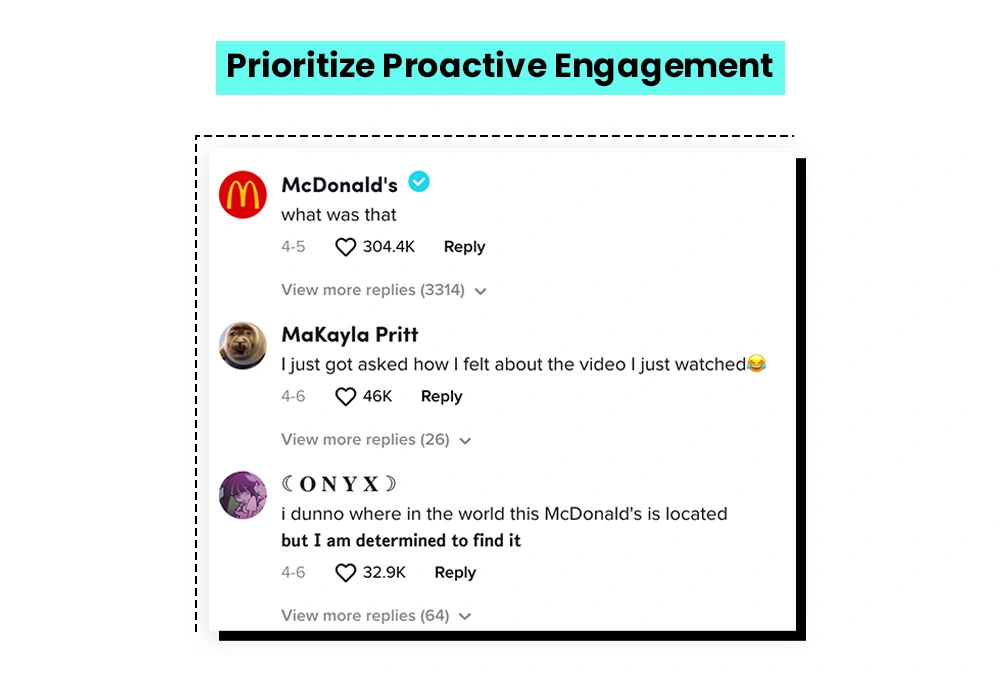
Here’s how to do it right:
- Track trending topics and viral posts on key social media platforms.
- Jump into conversations with on-brand, humorous, or helpful comments.
- Aim for visibility; top comments often rack up thousands of impressions.
Proactive engagement makes your brand memorable and expands your community without relying on paid ads.
3. Set A Content Creation Feedback Loop
Great content doesn’t happen in isolation. While social media community managers may not own the content creation process directly, their insights are key to making content hit the mark.
After all, they’re the ones in the channels—interacting with your audience daily, spotting trends, generating questions, and understanding what your followers truly care about. To truly boost your brand voice, community managers should work hand-in-hand with creative teams.
Here’s how to make that feedback loop seamless:
- Share audience insights regularly: What content sparked engagement? What questions or themes keep emerging?
- Spot potential brand advocates: Identify superfans or frequent contributors who might be open to features, testimonials, or UGC collaborations.
- Highlight engagement gaps: Check where content may have missed the mark or where more clarity could improve responses.
This ongoing exchange ensures your content remains relevant and resonates with your community. It also helps maintain a consistent brand voice across channels, one that reflects not just your brand’s personality, but the conversations your audience is already having.
When community managers and content creators collaborate consistently, every post becomes more intentional, meaningful, and memorable.
4. Encourage User-Generated Content (UGC)
In social media community management, user-generated content (UGC) is gold. It brings your brand’s story to life through the voices of your actual customers, adding authenticity, trust, and a sense of belonging.
As a social media community management agency would advise, here’s how to effectively spark and leverage UGC:
- Make participation easy: Create and promote branded hashtags so community members can tag you effortlessly.
- Prompt contributions: Encourage users to share reviews, experiences, or unboxings of your products or services.
- Offer incentives: Run giveaways, challenges, or offer small discounts to motivate submissions.
- Celebrate contributions: Share UGC across your platforms and always credit the creator. Acknowledge and thank them publicly, so it encourages others to participate too.
- Create community buzz: Highlight UGC in Stories, Reels, or feature posts to keep your brand top-of-mind and build a consistent loop of engagement.
The more your audience sees themselves reflected in your content, the more connected they’ll feel. And that connection is what transforms casual followers into loyal brand advocates.
– Also Read- How to Use User-Generated Content in eCommerce Marketing?
5. Utilize Listening Tools And Automation
Effective online community management isn’t just about showing up; it’s about showing up with purpose. Social listening tools like Sprout Social, Hootsuite, and Brandwatch help you monitor conversations, track sentiment, and identify social media trends across platforms in real time.
These tools can be your eyes and ears, giving you a deeper understanding of your audience’s needs. But here’s the catch—don’t rely entirely on automation, but always make room for genuine human interaction.
Use automation to:
- Flag mentions or comments that need attention
- Track recurring feedback and questions
- Schedule routine replies for FAQs
A real-time, empathetic response goes a long way in building trust within your online community. Know when to automate and when to step in personally. The goal is to be present, not robotic.
By balancing automation with thoughtful engagement, your community feels heard, valued, and connected, turning everyday interactions into lasting brand relationships.
– Also Read- 10 Social Media Marketing Mistakes Killing Your Organic Growth
Key Platforms for Community Management
Community platforms unite diverse audiences, develop meaningful connections, and foster collaboration. They empower members to engage, share, and support each other in achieving shared goals. Here are some of the key platforms:
1. Facebook Groups
Facebook Groups are a go-to platform for community building and, for good reason. They offer a space where your brand can go beyond broadcasting and start real conversations.
Whether you’re creating a group for loyal customers and industry people, the goal is the same: build a community that feels like home.
Here’s why Facebook Groups work:
- They build authentic, two-way communication
- Members can support each other and share feedback
- You can gather insights directly from your audience
When used thoughtfully, groups can become a hub for connection, trust, and long-term engagement.
2. Instagram (comments, DMs, lives)
Instagram is more than just a photo-sharing app; it’s a vibrant space for real-time connection and community management. Whether it’s responding to comments, engaging through DMs, or hosting interactive Lives, brands have countless touchpoints to connect meaningfully with their audience. It’s where your brand voice comes alive and where authentic conversations unfold daily.
Use Stories’ interactive features like polls and questions to spark engagement, and don’t overlook the power of a heartfelt reply to a comment—it builds loyalty. The key? Stay present, consistent, and human. Instagram rewards brands that prioritize relationships, not just reach. Your community notices when you truly show up.
3. LinkedIn Groups
LinkedIn Groups are crucial for building niche, professional communities. They’re perfect for B2B brands looking to spark thoughtful conversations, share insights, and build credibility.
Unlike broader social platforms, LinkedIn Groups encourage meaningful dialogue among industry people, potential clients, and thought leaders. It’s not just about posting; it’s about listening, responding, and creating value.
Share relevant content, ask questions, and acknowledge members’ contributions to keep engagement steady. Over time, you’ll create a loyal online community that sees your brand as a trusted resource. If you’re serious about long-term relationships in a professional space, LinkedIn Groups are well worth investing time in.
– Also Read- Boost Your Brand with LinkedIn’s Sponsored Newsletters
4. Quora, Reddit, Shopify and Niche Platforms
Quora, Reddit, Shopify, and other niche platforms are crucial for building genuine connections within your social media community. These channels succeed on curiosity, conversation, and credibility.
Unlike mainstream social media, here the focus is on problem-solving and deep discussion, which is perfect for brands that want to build trust and showcase expertise. Here’s how to tap in effectively:
- Quora: Answer audience questions with helpful, insightful responses and build authority over time.
- Reddit: Join subreddits relevant to your industry. Be transparent, avoid direct selling, and contribute meaningfully.
- Shopify Community: Offer tips, answer store setup queries, and be a go-to source for fellow merchants.
- Niche forums: Connect with hyper-specific audiences who care deeply about your topic.
– Also Read- Reddit’s New Keyword Targeting for Improved Ads
3 Social Media Community Management Examples From Real Brands
Thriving brand communities unite people around a shared passion for your mission or goals. Discover how to turn business objectives into loyal fans with these 3 standout social media community management examples.
1. Airbnb
Airbnb takes community building to the next level by encouraging both hosts and guests to share their unique experiences. Using the hashtag #AirbnbHostStories, users post personal stories and travel photos, which Airbnb actively engages with and reshapes into inspiring content.
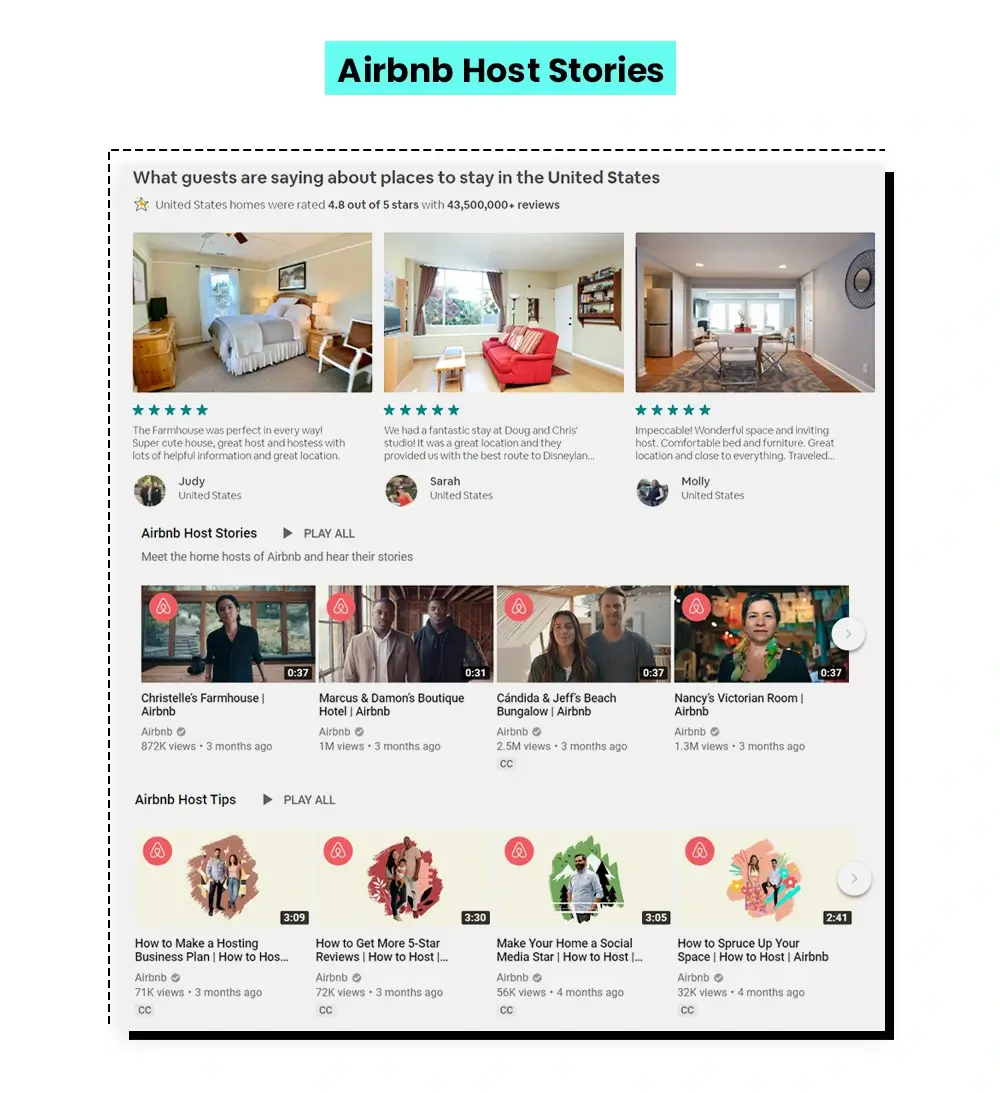
This approach transforms Airbnb from a simple vacation rental platform into a thriving community where people feel connected through shared adventures. By highlighting these stories, Airbnb develops a strong sense of belonging, turning customers into loyal brand advocates who love being part of the journey.
2. Netflix
Netflix does a great job with community management by making social media fun and friendly for fans. On Instagram and X (formerly Twitter), they post memes, behind-the-scenes clips, and reply to fans with funny, friendly messages.
They also join live conversations and often share fan art or tweets. This makes followers feel valued and part of something special. People enjoy knowing their content might be noticed or shared by Netflix. It’s a smart way to turn viewers into an active and loyal community.
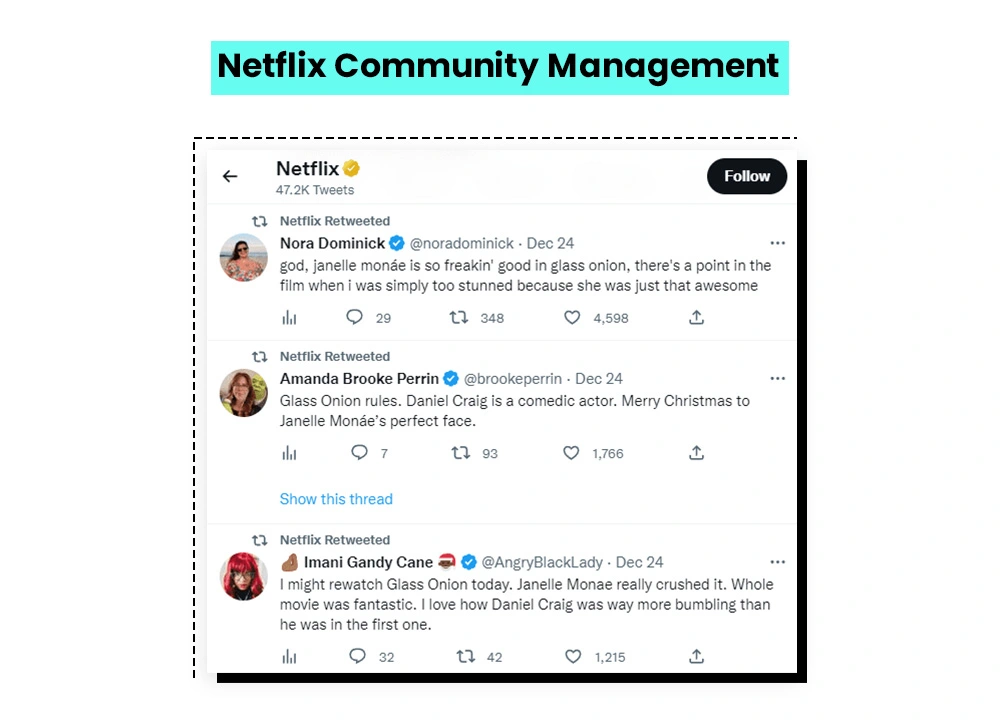
3. Lyft
Lyft stands out with its super-responsive social media game. Whether it’s a joke, a complaint, or a funny ride story, Lyft’s team is quick to reply, tag, or not tag. This consistent engagement shows off their fun, friendly brand voice and makes people feel heard.
Scroll through their Twitter replies, and you’ll see how their playful tone brings personality to the brand. It’s a great example of how staying active in conversations builds strong, relatable community connections online.
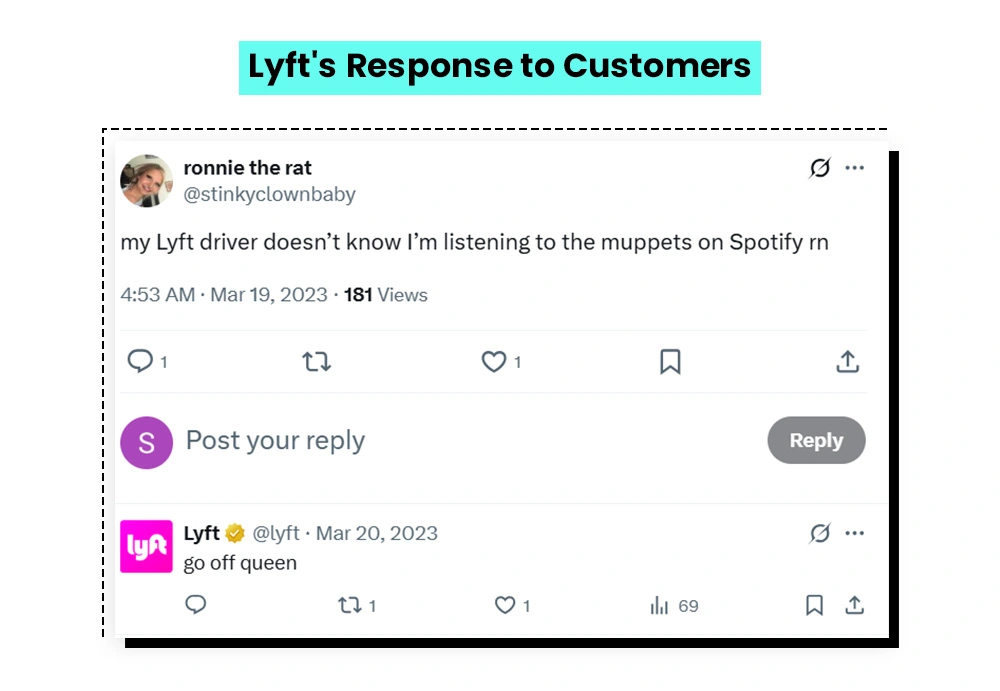
Conclusion
Social media community management isn’t just about responding to comments, it’s about building real relationships that grow your brand in the long run. When done right, it helps expand your organic reach, strengthens loyalty, and shapes a brand voice people genuinely connect with.
From setting clear goals to choosing the right platforms and showcasing your community, every step matters. Want to turn your followers into fans and advocates?
Reach out to Mastroke to use these best practices to shape a social media community management strategy that delivers lasting impact.